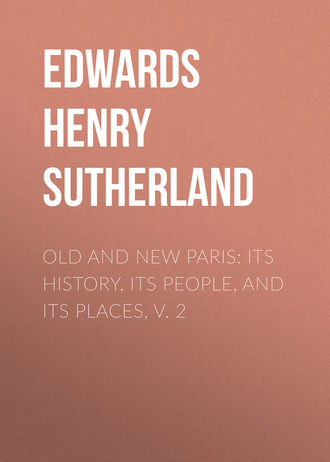 полная версия
полная версияOld and New Paris: Its History, Its People, and Its Places, v. 2
Dr. Le Fort draws a very strong contrast indeed between the Paris hospitals and the “houses of assistance.” The former institutions he declares to be, as a whole, the “most defective and murderous in Europe”; the latter, a “title to glory” for the city of Paris. He attributes the difference to the fact that the medical element is eliminated from the direct administration of the hospitals, but allowed its proper sway in the “benevolence” system. Certainly, one advantage of this system is that it strengthens those family ties which a long residence in hospital relaxes and too often breaks.
In connection with the hospitals and relief institutions of Paris must be mentioned the National Institution for Blind Children, founded just after the Revolution by Louis XVI., before the Republican form of government had been definitely adopted. Its initiator was Valentine Hauy, the mineralogist, to whom a statue has been erected in the principal courtyard. The Institution for Blind Children is one of the ten general establishments of benevolence conducted under the immediate authority of the Minister of the Interior by a responsible director, assisted by a consultative commission. The instruction given is (according to a writer on the subject who evidently does not set too high a value on music) “technological, musical, and intellectual.” Employment is found for the children on the completion of their studies.
The house of the strangely named Quinze Vingts is designed for the reception of 300 blind persons of both sexes, each with his own private apartments for himself, or himself and family, together with many other advantages as well in money as in kind. Attached, moreover, to this institution are 1,300 outside pensioners in all parts of the country, receiving assistance in money according to the class to which they have been assigned: 200 francs, 150 francs, and 100 francs.
The origin of the Quinze-Vingts, or Fifteen-Twenties, is lost in obscurity. Hence all sorts of contradictory stories and conjectures without foundation, substituted for positive documents. According to some authors St. Louis, on his return from Palestine, founded the establishment of the Fifteen-Twenties for 300 knights – the sad remains of his army.
But the writers of the time make no mention of this alleged fact, and the ordinances of St. Louis contain no sort of reference to it. The legend of the 300 knights must therefore be regarded as a fable. It is certain meanwhile that the blind asylum dates from an epoch anterior to the reign of St. Louis, though it is quite true that this pious monarch, by his patronage and his liberality, became the real founder of the house.
The Fifteen-Twenties forming a mendicant corporation, subsisting by alms, and belonging body and soul to their own Order, were first established in the Rue St. Honoré, not far from the Tuileries. They remained there under the constant patronage of numerous and powerful protectors until 1779, in which year Louis XVI. transferred the asylum to the ancient residence of the Black Musketeers in the Rue de Charenton. Its revenues already amounted to more than 370,000 livres (i. e. francs). The constitution of the hospital was then modified, collections in the churches were forbidden, and mendicancy in the streets likewise. At the same time regular pensions were introduced.
Towards the gate of a modest edifice situated in the Rue St. Jacques, near the Luxemburg Garden, may daily be seen visitors attracted to this point from all quarters of France and even of the globe. The building they wish to enter was, until 1794, the seat of the minor seminary of St. Magloire, belonging to the Archbishop of Paris. In this year he ceded the house to the deaf and dumb institution, which, founded in 1760 by the Abbé de l’Épée in his own domicile, Rue des Moulins, was, just after the Revolution, raised to the dignity of a national establishment and transferred to the ancient monastery of the Célestins near the Arsenal. The national institution of the Rue St. Jacques, which still exists and which is under the direction of the Minister of the Interior, contains some 210 pupils of from seven to fourteen years. The school comprised, until lately, two divisions entirely separate and distinct, one for boys, the other for girls, when suddenly the girls of the Paris institution were sent to the institution of Bordeaux, and the boys of the Bordeaux school to that of Paris, so that at present, wherever they may have been born, the deaf and dumb boys are all at Paris, while the deaf and dumb girls are all at Bordeaux. Professor Ferdinand Berthier, of the Paris deaf and dumb school, himself deaf and dumb, maintained, in an article published some five-and-twenty years ago, that this pretended reform was no amelioration whatever; the deaf and dumb children studying perfectly well when the boys and girls were educated together under the same professors. At that time the Paris institution was administered by a director with the use of speech, assisted by an examiner of studies, similarly gifted, and a body of professors, some of whom spoke, while others were deaf and dumb.
One of the best private deaf and dumb institutions in France is at Lyons. It contains a good number of pupils of both sexes, and its director is, or was until recently, M. Claudius Forestier, a very distinguished deaf-mute; his wife, a highly educated person – the speech-endowed daughter of the deaf-mute founder of the school – acting as directress.
The number of deaf-mutes in France has been approximately estimated at 25,000; and here, as in nearly all countries where statistics are published, it is found that the male sufferers are decidedly more numerous than the female.
To each establishment, public or private, workrooms are attached, conducted by competent instructors, and in which all the pupils, poor or rich, serve an apprenticeship to some profession, art, or trade which will one day enable them to earn a subsistence. No longer, therefore, is the community encumbered by deaf and dumb idlers; the men and women thus afflicted leading active lives as shoemakers, dressmakers, tailors, sempstresses, locksmiths, compositors and even painters and sculptors.
It has been complained that the deaf and dumb institutions of France – about fifty in number – are insufficient for the instruction of 25,000 deaf-mutes, many of whom must consequently be deprived of instruction in those employments for which they are generally as apt as their neighbours who can speak and hear.
The question of the hereditary nature of muteness has been a good deal discussed by French experts. “Dumbness,” says Ferdinand Berthier, “far from being a necessary result of deafness, simply follows the latter by reason of a natural sequence. Whether deaf-muteness dates from birth or from some accident, it has been proved in the present day that the vocal apparatus of the deaf-mute and that of a speaking person are with rare exceptions equally well organised. A prejudice still too widely spread in the world, and worthy of every effort towards its destruction, is that deaf-muteness is infallibly transmitted from father or mother to child; when on all sides we see deaf-mutes, married between themselves or to speaking spouses, constantly producing children who both hear and speak, and in no way share the parental infirmity. Those arts which have enabled the sublimest efforts of genius to dazzle the world do not, in our opinion, merit greater attention from scholars and philosophers than the method which shall open to the deaf-mutes a road leading to intellectual labour and to the full enjoyment of civil and political rights.”
Looking back to antiquity, this excellent writer points out that the ancients regarded the education of deaf-mutes as an impossibility both physical and moral.
It was the custom at Sparta to allow children suffering from this double infirmity to die of hunger and thirst in the desert, where they were for that purpose exposed; and the laws of Solon were on this point no less severe. Aristotle, if he did not precisely justify the rigour of such laws, at least endorsed the moral prescription. In the fourth book of his History of Animals he unhesitatingly relegates deaf-mutes to the rank of idiots, declaring them hopelessly beyond all tuition. The Republic of Rome did not show itself more humane. It was in vain that intelligence beamed in the face of these unhappy victims: if their tongue could produce no sound they were condemned to be flung into the Tiber.
One of the earliest agents in the removal of this weight of infamy from the fraternity of deaf-mutes was, curiously enough, the stage. Lucian eulogises the pantomime of the dumb-show actors of his epoch, and the admirable influence they exercised in raising the deaf and speechless above general contempt. The Egyptians and Persians, more civilised and enlightened in this respect than Sparta, Athens, or Rome, showed for their deaf-mutes a solicitude which approached devotion.
In centuries less remote many efforts have from time to time been made by philosophers and philanthropists to invent an effectual method of instructing deaf-mutes. The sign method of the Abbé de l’Épée was one of the first great steps in this direction. The abbé held that the old-fashioned dactylology was insufficient, and that signs were essential to those who could neither hear nor speak. Starting from the incontestable principle that the bond existing between ideas and sounds which strike the ear is not more intimate, more natural, than the bond between ideas and traced characters which strike the eye, he found it by no means difficult to demonstrate the possibility of fully replacing speech, in the case of a deaf-mute, by mimicry.
As regards this mimicry, M. Berthier cautions people against the common mistake of confounding it with dactylology, or the language of the fingers. Dactylology is confined to the servile reproduction of the letters of the alphabet of any particular language, one by one, syllable by syllable, word by word, or in no matter what other conventional manner. Mimicry, a faithful picture of human thought, paints ideas and sentiments in a living language – the innate language of all nations – the language of humanity. By means of it thoughts are exchanged more quickly than by speech or writing – not to mention dactylology, which lags so far behind.
In the midst of his brilliant triumphs the Abbé de l’Épée had frequently to engage in conflict with two classes of powerful adversaries: the philosophers and the theologians; the former regarding words as the only vehicle for imparting metaphysical ideas, the latter regarding them as the sole means of inculcating supernatural religious truths.
Louis XVI. had granted the abbé out of his own privy purse an annual pension of 6,000 francs, in addition to his official appointment at the Célestins. Hitherto the school had, for twelve years, been maintained entirely at the cost of the founder, aided by such occasional alms as he received for the purpose. It was at the Célestins in 1789 that he expired, amid the weeping of his pupils and with the delightful thought that his work would not perish with him.
Amongst the disciples of the Abbé de l’Épée must be mentioned the Abbé Sicard, canon of Bordeaux, whom the archbishop of that town sent to Paris, where he had founded a deaf-mute institution, in order that he might study under de l’Épée that method of which there was so much talk. The high talents of this young priest soon enabled him to divine, comprehend, and complete the thought of his master in exciting the warm sympathies of the public towards those unfortunate persons whose tongue was tied and whose ear was stopped.
On the death of de l’Épée, Sicard competed for and was unanimously awarded the management of the abbé’s institution. Having already written not a little on the subject of deaf-muteness, he now published other works, “A Deaf-mute’s Course of Instruction,” among others, which only served to increase his renown; though in this treatise there was indeed one highly objectionable assertion concerning the condition of a deaf-mute which the author found it necessary to retract in his “Theory of Signs.”
During the Revolution of 1793 the Abbé Sicard did not escape persecution. Flung into prison after the eventful 10th of August, he was lucky enough to keep his head on his shoulders during the massacres of September. He had scarcely been set at liberty when, as editor of the Catholic Annals, he was condemned to transportation to Cayenne; and he passed the next two years of his life in flight far from his beloved institution, of which he did not resume the direction till after the Revolution of the 18th “Brumaire.” He died in 1822.
Among the professors whom he formed must be mentioned a speech-endowed one named Bébian, who in his turn trained several deaf-mute professors. His works are still consulted with advantage both in France and abroad by those who wish to devote themselves to this arduous method of instruction. The object he kept before him in writing was, as he himself expressed it at the commencement of one of his books, “to simplify the method and render it so easy that the mother of a family can teach her deaf-mute child to read just as she teaches the others to speak.”
Oblivion had already seemed too long to have overspread the remains of the Abbé de l’Épée when, in 1837, on the initiative of M. Berthier, a numerous and distinguished committee was formed for the purpose of raising to the clerical philanthropist a monument worthy of him in that chapel of the church of St. Roch which belonged to his family, and in which he was accustomed to celebrate mass, assisted by deaf-mutes. It was here indeed that his ashes lay. An admirable sculptor, M. August Préault, was unanimously chosen to interpret the homage which so many famous deaf-mutes and others wished to pay to the abbé’s memory, and he worthily carried out the intentions both of committee and subscribers. Eight years afterwards, in 1845, a crown of laurels in bronze was placed beside the monument with this simple inscription: “To the Abbé de l’Épée, from the Swedish deaf-mutes.” This crown, beautifully executed, was likewise the work of Préault. The year previously the same sculptor had testified his own admiration of the abbé by contributing to the Hôtel de Ville a fine statue of him. The town of Versailles, which was proud of being the birthplace of the great founder of the deaf-mute institution, could not do less than follow the example set by Paris in voting to his memory a statue, which was confided to the chisel of M. Michant. The same artist was subsequently commissioned by the Count de Montalivet, then intendant-general of the civil list, to execute a bust of the abbé for the historic gallery of Versailles.
The Paris hospitals are not, like ours, supported by voluntary contributions. Many of them have from the beginning been richly endowed. Others depend on grants from the State or from the Municipality; while a few are maintained from mixed sources. None of them, however, depend, as in England, on subscriptions and donations received periodically from charitable persons. Consequently, applicants for relief or advice need neither letters of recommendation nor introductions of any kind. Medical succour is given at certain hours to all who choose to ask for it. Patients seeking admission and regular attendance have sometimes to wait for their turn. But there are, in proportion to the population, quite as many beds at the service of the sick in Paris as in London.
Of the most ancient and most famous of all the French hospitals – the Hôtel Dieu – mention has already been made. Scarcely less celebrated, in view of the important services they have rendered and of the many physicians and surgeons of eminence who have lectured, operated, and prescribed within their walls, are the two hospitals named after those divine qualities Charity and Pity.
The Hospital of La Charité is the principal one on the left bank of the Seine; nor is its position likely to be forgotten by those who have heard of the famous professor of surgery – Lisfranc – and his attacks upon the illustrious Dupuytren, head of the Hôtel Dieu, whom Lisfranc, in his highly polemical lectures, used habitually to describe as “ce brigand de l’autre côté de l’eau.” Lisfranc had doubtless differed with his eminent rival on some slight theoretical point, for which reason he accused him, with a vehemence which Molière’s own doctors might have envied, of mental perturbations and moral offences in no way attributable to him.
No less than three benevolent institutions have been founded in Paris under the name of Charity – the Hôpital de la Charité Chrétienne, endowed and opened by Marguerite de Provence, widow of Louis IX., but destined in the course of ages to disappear; the Maison de la Charité, founded by the town of Paris at the beginning of the sixteenth century, with the aid of Francis I., against epidemics, afterwards to become known as the Maison de la Santé; and finally, the Hôpital de la Charité, already referred to, which remains one of the first medical and surgical institutions in Paris.
The origin of La Charité and its history up to the time of the Revolution are sufficiently curious. A hospital was founded at Grenada in 1540 by St. John of God, who became the chief of a religious order which occupied itself specially with the care of the sick. This congregation of hospitallers spread rapidly throughout Europe, and a certain number of its members being, in 1602, at Paris, Marguerite de Valois, the divorced wife of Henry the Fourth, who in her old age, when her passions had somewhat subsided, became religious, enabled them to establish a hospital, to which the name of La Charité was given. The brothers of the Order of St. John of God had already a place of their own, which they gave up in order to take possession of the larger premises placed at their disposal by Queen Marguerite. A capacious house, surrounded by vast gardens, was the first home of La Charité. Here patients were received and treated by the brethren, who, besides religion, had studied medicine, surgery, and pharmacy. Their vows did not allow them to admit women, and their utility seems to have been further limited by insufficient knowledge of the art of healing; and this notwithstanding the fact that several of the brethren made themselves a great name as surgeons and physicians. In the early part of the eighteenth century they joined to their staff medical men from the ranks of the laity; compelled to this step by an edict from the Parliament of Paris which ordered them to admit, without salary, a surgeon-apprentice to help them in dressing wounds, and a master-surgeon to share their labours generally. Throughout the eighteenth century they found themselves constantly exposed to attacks from the members of the various medical and surgical guilds, who claimed the sole right of attending the sick and wounded.
In 1792, three years after the outbreak of the Revolution, the different religious congregations were broken up, and the Hospital of La Charité was placed under the direction of the Municipality of Paris. The very title was abolished, and instead of Hôpital de la Charité – beautiful and suggestive name! – it was now called, without the least significance, Hôpital de l’Unité. Under the Restoration, however, its old name was given back to it; and since then, under many changes of government, it has retained its original appellation.
Among the other hospitals of Paris the most important are those of La Pitié and of St. Louis, to which may be added L’Hôpital du Midi, and a number of special hospitals, such as the one known as La Maternité, founded in 1795, which is at once a school for the instruction of wet-nurses, and a maison d’accouchement, or lying-in hospital.
CHAPTER XXIX.
LUNATIC ASYLUMS AND MIXED INSTITUTIONS
The Treatment of Lunacy in the Past – La Salpêtrière – Bicêtre – The Story of Latude – The Four Sergeants of La Rochelle – Pinel’s Reforms – CharentonOUR description of the hospitals and asylums of Paris would be scarcely complete without some mention of the public madhouses. In pre-revolutionary Paris no special establishment for the treatment of the insane existed. Strange as it may seem, there were no lunatic asylums in France until the beginning of this century; nor until 1838 was any such institution formally recognised by law. We have not far to go back to find the demented treated as criminals, or exorcised as demoniacs, or put to death as magicians and sorcerers. Mr. H. C. Burdett, who has recently published a work on the hospitals and asylums of the world, divides the history of lunatics and their treatment into four periods.
I. An early period when, at the beginning of the Christian era, the insane were brought together and placed under intelligent control. – In this connection Mr. Burdett cites the rules given for the treatment of lunatics by Aretæus (A.D. 80) and Soranus (A.D. 95). The latter, in particular, gave directions of great minuteness as to the temperature and furniture of the rooms, the arrangements of the bed, the physical and mental exercises to which the patients afflicted with dementia were to be subjected. The superintendents, according to the rules of this period, were to have strict instructions to repress the errors of the patients in such a way as not to exasperate them by too much sharpness, and yet not permit them, by too much weakness, to increase their unreasonable demands. Subsequent writers deal with insanity in a like spirit of enlightenment down to Paulus Ægineta (A.D. 650).
II. The period of slaughter. – In the Middle Ages the treatment of lunatics was worthy only of the ages characterised as dark. A madman was worse treated than a mad dog. For twelve centuries lunatics were commonly put to death, and in most cases by burning at the stake. In France alone twenty thousand are said to have been burnt in a hundred years; and the same thing went on in every other country. Those who were not burnt wandered at large in a wretched condition, to die at last from exposure; or they were confined in dungeons, starved and cruelly maltreated. Ambrose Paré, the celebrated French surgeon, medical attendant of Francis I., fully believed that lunatics were possessed by the devil. “They may often be seen,” he says, “to change into goats, asses, dogs, wolves, crows, and frogs; they cause thunder and lightning, lift castles into the air, and fascinate the eye.” King Louis XIV. has been much reproached since his death as he was adulated during his lifetime. To him, in any case, is due the first movement against the cruel – the absolutely insane treatment of the insane. In 1670 a trial took place in Normandy which ended in the condemnation of seventeen people to the stake, either as lunatics or as sorcerers. A rat, it was sworn, had been seen talking to a child; and on the strength of this evidence everyone who could be brought into connection with the strange incident was sentenced to death. The king was indignant, and soon afterwards a decree was published forbidding trials of the kind in future.
III. The period of torture. – Though no longer subject to death punishment by fire, lunatics were almost as badly off in the eighteenth and at the beginning of the nineteenth century as at an earlier time. Such asylums as existed in France and other countries up to the present century were entirely of a monastic kind; and it was not, as before mentioned, until the reign of Louis Philippe that any regular secular institution for the treatment of the insane was founded. The unhappy lunatics were probably happiest in those countries where least notice was taken of them; for not a century ago they were liable, when “cared for,” to copious bleeding, shower-baths, sudden frights, and rigid coercion. In some places they were chained and flogged at the changes of the moon, or they were placed under the charge of criminals, who set dogs on them and tortured them to death. The doctors, instead of checking these barbarities, encouraged them; and from time to time invented new ones. They it was who introduced the “circular swing” and “bath of surprise.” One torture, diabolically devised, was to lower the patient into a well, chain him there, and allow the water to rise gradually to his mouth in order to give a shock to his nerves. An unhappy man named Norris was in England, at the so-called Hospital of Bethlem, fixed to the wall by the neck and waist so that he could not move a foot or raise his arms; and, thus attached, he remained for twelve years.







